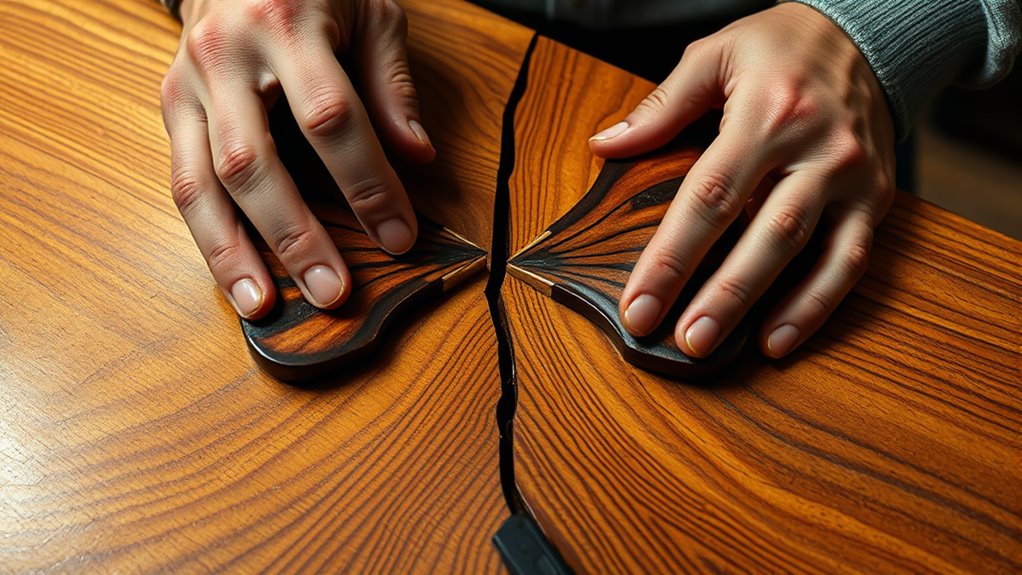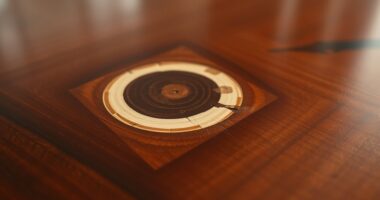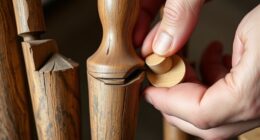To fix a cracked tabletop, start by cleaning the damaged area thoroughly and routing a small groove if needed. Use butterfly keys or dowels to align and strengthen the repair, gluing them securely in place. Fill the crack with epoxy, working carefully to avoid bubbles and ensure deep penetration. Allow the epoxy to cure fully before sanding smooth and finishing to blend the repair seamlessly. Keep going to discover more detailed steps for a durable, smooth fix.
Key Takeaways
- Clean the cracked area thoroughly to ensure proper adhesion before applying butterfly keys or epoxy.
- Use contrasting wood butterfly keys to align and reinforce the crack while adding visual appeal.
- Mix epoxy carefully and fill the crack completely, working slowly to avoid trapping air bubbles.
- Secure broken pieces with wooden dowels or butterfly keys for added structural support.
- After curing, sand the surface smoothly and finish to blend the repair seamlessly with the tabletop.

A cracked tabletop can be frustrating, but fixing it is often straightforward with the right approach. When dealing with a break or split, your goal is to restore strength and appearance using effective repair techniques. One of the most reliable methods involves understanding wood jointing and epoxy techniques, which work together to create a durable, seamless repair. Wood jointing is essential because it ensures that cracked pieces are aligned properly and held securely. Epoxy, on the other hand, acts as a strong adhesive and filler, sealing cracks and reinforcing the structure from within.
To start, clean the damaged area thoroughly. Remove any loose splinters, dust, or debris with a brush or compressed air. This step is crucial because dirt or loose fibers can weaken the bond. If the crack is wide or jagged, you might consider routing a small groove along the crack to improve adhesion. Once prepared, you’ll want to join the broken pieces securely. Using wood jointing techniques, you can insert butterfly keys or dowels across the crack to provide mechanical support. Butterfly keys are particularly popular because they not only strengthen the joint but also add an attractive visual element. These are typically made from contrasting wood, cut into shapes that fit neatly across the crack, and glued in place with a strong adhesive.
Next, mix your epoxy carefully following the manufacturer’s instructions. Epoxy techniques are vital here because they allow you to fill the crack completely, sealing it from moisture and further damage. When applying epoxy, use a putty knife or small spatula to push the mixture deep into the crack and around the butterfly keys or dowels. Be sure to work slowly to avoid trapping air bubbles, which can weaken the repair. Once filled, wipe away excess epoxy with a damp cloth before it sets. After curing, you’ll need to sand the area smoothly, blending the repaired section with the surrounding surface. This process ensures that the repair is invisible or minimally noticeable, restoring the tabletop’s original appearance. Additionally, utilizing proper epoxy curing techniques guarantees a stronger, more durable repair.
Frequently Asked Questions
How Long Does a Butterfly Key Repair Typically Last?
A butterfly key repair can last for decades if installed properly and maintained well. Durability considerations include using quality wood and ensuring a tight fit to prevent further cracking. You should regularly check for signs of movement or wear, and keep the surface clean to avoid moisture damage. Applying protective finishes and avoiding heavy impacts also extend the repair’s lifespan, helping your tabletop stay sturdy and beautiful for years to come.
Can Epoxy Fills Be Used on Outdoor Tabletops?
Yes, you can use epoxy fills on outdoor tabletops, but choose a weather-resistant epoxy designed for exterior use. These epoxies offer enhanced durability and can withstand moisture, temperature changes, and UV exposure. To guarantee long-lasting results, select a high-quality, outdoor-rated epoxy, properly prepare the surface, and follow the manufacturer’s instructions carefully. This way, your repair will maintain its strength and appearance despite outdoor weather conditions.
Are There Color-Matching Options for Epoxy Fills?
Yes, you can find color-matching epoxy options that blend seamlessly with your tabletops. When choosing epoxy fills, look for tinted or pigmented epoxy products designed for color matching. You can also add colorants or pigments to clear epoxy to match your wood or surface color precisely. Carefully selecting the right epoxy options guarantees your repair remains discreet and enhances the overall appearance of your tabletop.
What Tools Are Needed for Installing Butterfly Keys?
You’ll need a drill with appropriate drill bits to create precise holes for the butterfly keys. Make sure to choose bits that match the size of your butterfly keys. Clamps are essential for securing the workpiece and ensuring proper alignment during installation. You might also need a chisel, pencil, and measuring tools to mark and fit the butterfly keys accurately. With these tools, you can confidently repair the cracked tabletop.
Is Professional Help Recommended for Large Cracks?
For large cracks, professional help is highly recommended because DIY techniques might not guarantee long-lasting results and could lead to further damage. Hiring an expert might cost more upfront but can save you money in the long run by providing a durable fix. Considering cost considerations, professionals use specialized tools and techniques, ensuring the crack is properly stabilized and aesthetically restored, which might be difficult to achieve on your own.
Conclusion
By repairing your cracked tabletop with butterfly keys or epoxy fills, you’re not just restoring its surface—you’re giving new life to a cherished piece. Remember, cracks can be like wounds that tell stories; with patience and care, you can turn scars into symbols of resilience. So, embrace the process, and let each repair remind you that even broken things can become beautiful again—proof that strength often comes from fixing what’s been damaged.









